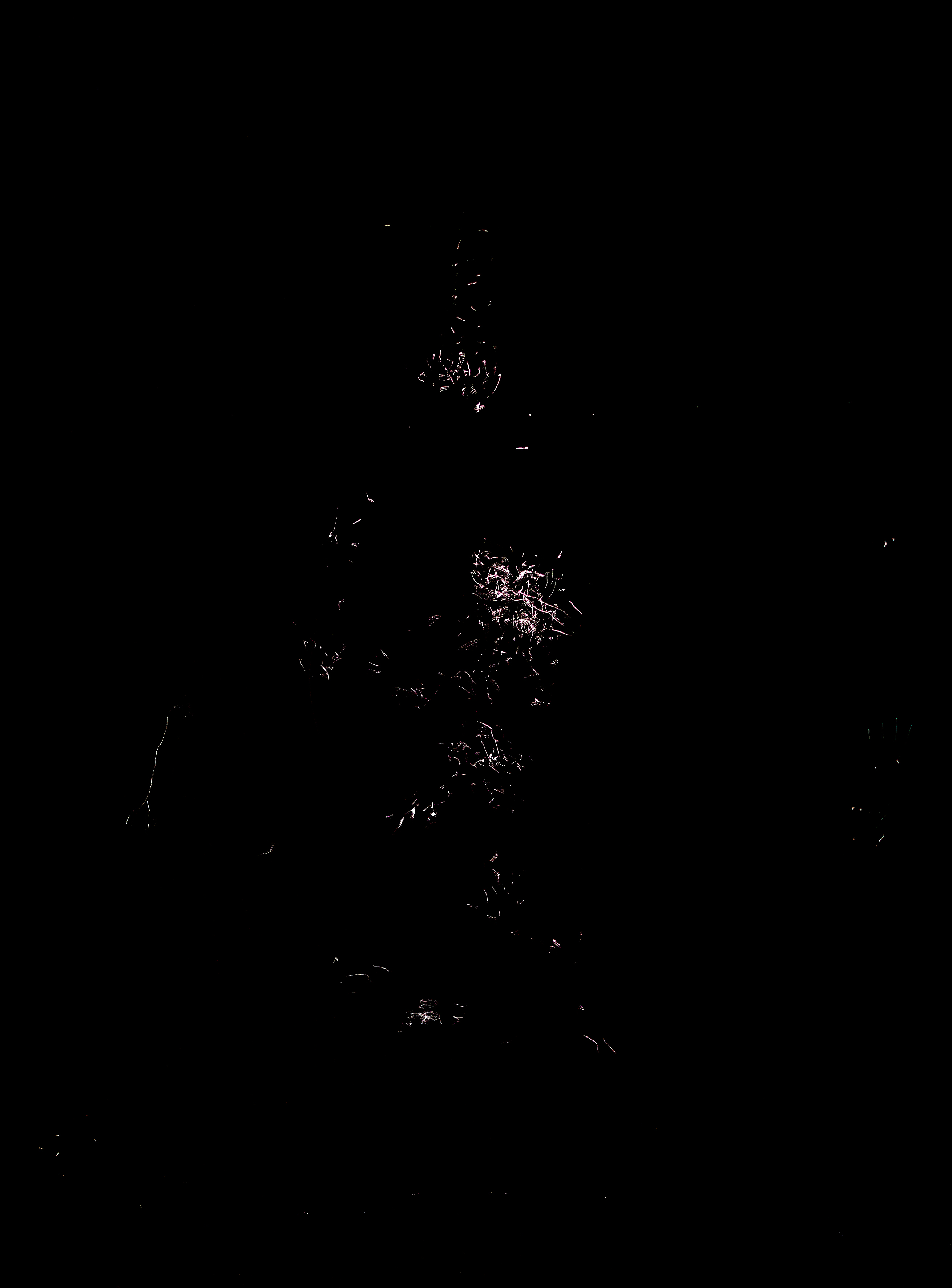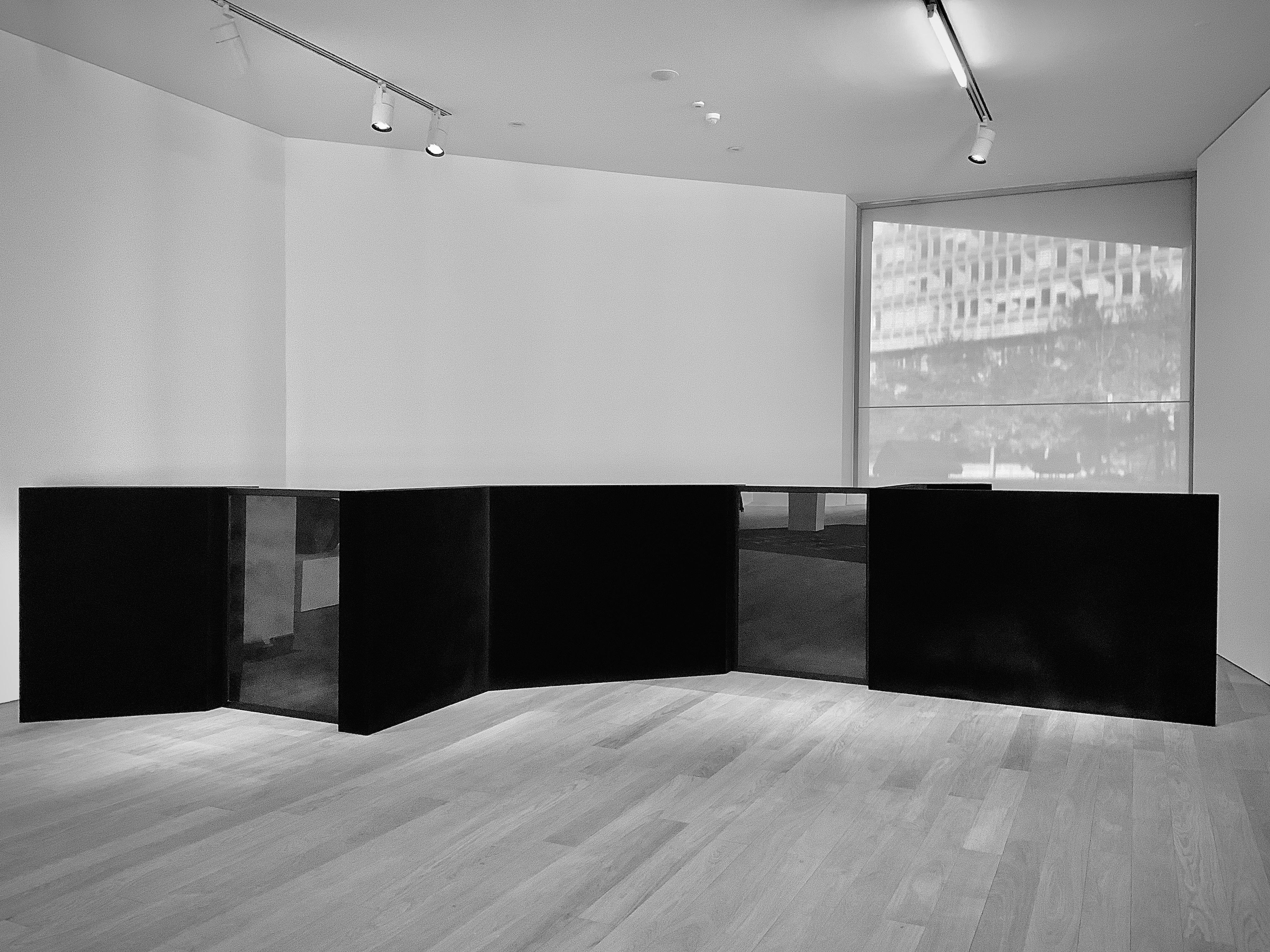
(détail fenêtre avec traces laissées par les papillons de nuit)
photo: Remi Villaggi


(détail fenêtre avec traces laissées par les papillons de nuit)
photo: Remi Villaggi

My work with the opacity of soot and the traces of moths confronts them with devices of capture — the Platonic solid, the museum window, the flatbed A4 scanner. These lamp-sculptures that attract the moths are not innocent lanterns: they are traps, abrupt interruptions that cut sharply into our attempts at grasping. Their harshness resonates with the deeper contradictions at the heart of my work: neither geometrical reduction, nor mechanisms of cultural standardization, nor bureaucratic fixing align harmoniously with the ineffability of moths. This disharmony is precisely the point. Coexistence is never pure, rarely without friction, often shot through with violence. To live is always to intrude, to consume, to displace — whether in the violence at work in feeding, or in the inevitable crushing of an ant along the path of a walk. What the moths reveal when they spiral around an artificial light is not a moral failure, but the impossibility of seamless cohabitation. These works stage this impossibility, carrying the contradiction like one carries the hollowed interior of a bell pepper turned to bronze, its weight pressing heavy in the hand.
https://www.mudam.com/exhibitions/freigeister-fragments-of-an-art-scene-in-luxembourg-and-beyond
The work of Yann Annicchiarico addresses our perception and confronts our human nature with worlds that are inaccessible to it. Inseparable from the still or moving bodies exploring a space, the act of seeing in Annicchiarico’s work prompts an awareness of the limits of our own understanding and the possibility of transcending these limits. A shift from intelligibility to sensibility occurs when we grasp the impenetrability of dimensions that are foreign, yet close. Interacting with their environment through an interplay of different scales and temporalities, Yann Annicchiarico’s installations allow one to experience the physical sensation of being on a threshold, of finding oneself in an in-between. The scenic, even theatrical nature of his work also emphasises its connection to memory. His pieces engage with the capacity of one’s memory to recall a given succession of events or appearances – to mentally reconstruct them – to better project oneself into other potentialities. A constant back-and-forth between erasure and emergence.
Formally, Yann Annicchiarico’s modular constructions involve two- and three-dimensional geometrical features made of everyday building elements: doors, windows, stairs. Chosen for their primary uses as thresholds and passageways, as openings, as ways of access and progression, these architectural components function as simplified archetypes, imparting them with an abstract character. Although the materials appear neutral, their various origins conceal a multitude of dimensions. Indeed, the artist is very interested in the natural sciences. The study of biodiversity, of living forms and their environments, is a source of conceptual inspiration for a body of work in which the natural world, be it organic or mineral, meets that of metaphysical abstraction and ideal forms. One geometric shape often recurs: the dodecahedron, a Platonic solid of the highest degree considered by the ancient Greek philosopher as the substance of all things. In the material world its polyhedral structure is found in the pyrite crystals the artist has used in some of his work, such as Entre géométrie pyrite et vol de mouches [Between Pyrite Geometry and the Flight of Houseflies] (2014), in which an insect’s flight path is traced around a suspended dodecahedron. All of Yann Annicchiarico’s work is open to a multitude of possibilities thanks to the irreducible gaps between worlds – those of the living, those of matter, those of ideas. Their unique temporalities, shifting between transience and eternity, are equally incompatible. So, as we make our way, our perception takes on an entanglement of realities that coexist in suspended time.
However, his very elaborate work is also open to the unexpected and the accidental. In Noir de fumée et papillon de nuit [Soot and Moth] (2014), an unexpected insect visitor found its way into a miniature constellation the artist had made by blackening the glass surfaces of a dodecahedron with candle smoke. The moth marked its passage in the film of soot. Upon realising what had happened the next morning, the artist chose not to erase the traces of this strange occurrence and preserved the thin white streaks on the black ground, retaining material proof of another species’ reign. Since then, the artist’s practice has regularly featured the figure of the moth. He says it acts as the activator of the gap between two worlds. A lepidoptera was also called upon for Nachtfalter (2021), shown at Mudam; it is responsible for the miniature cosmos visible on the glass panes of the 1:3 replica of the exhibition space wall. This light-absorbing matte black sculpture is installed across from the original wall, acting as its negative double. It stretches out like a screen, preventing us from physically but not visually accessing the space situated beyond the boundary it delineates.
text Clément Minighetti
translation Simon M. Benedict
Freigeister is an exhibition developed to mark the 15th anniversary of the museum. Conceived as a subjective portrait of the contemporary art scene in Luxembourg, it brings together the work of 14 artists born in the 1970s and 1980s. Presenting works in a range of media, from painting, photography, installation and sculpture, as well as film and virtual reality, the artists are connected via the links they have forged between Luxembourg and other countries and through their backgrounds or personal journeys, thus reflecting Luxembourg’s openness to the world beyond its borders.
Freigeister also highlights the vital role that artists play in contemporary society through the perspectives they bring, from the critical to the engaged, and from the idiosyncratic to the poetic. It underscores, moreover, their ability to question established frameworks, ideas and forms – to act, in the words of German philosopher Friedrich Nietzsche (b. 1844, Röcken, Germany – d. 1900, Weimar), as ‘free spirits’.
A distinctive aspect of the exhibition is the process of its creation. Freigeister was built on the model of a collaborative platform combining moments of collective thinking about the exhibition project and meetings with guest speakers – researchers, writers, heads of institutions and association leaders – about themes that resonate most strongly with Luxembourg today, including the subjects of migration, languages, living together, the commons and territory.
The Freigeister exhibition does not seek to illustrate these themes, but it is informed by the discussions that led to its creation. It brings together new works commissioned from the participating artists in response to the context of the exhibition – fragments of an art scene that is characterised by its vitality and plurality.